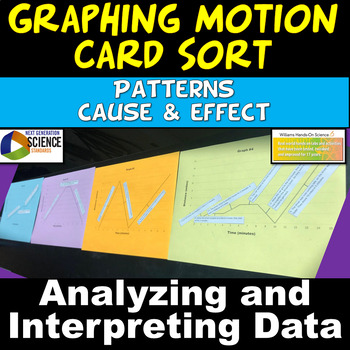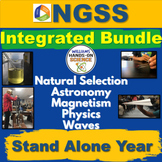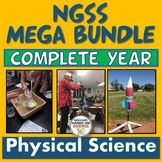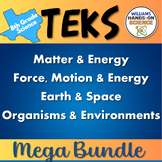NGSS MS-PS2-4 MS-PS2-2 Graphing Motion Card Sort & Graphing Questions
- Zip
Also included in
- Your students will remember these activities forever! These are student centered, challenging, hands-on, engaging activities that will wow and motivate even some of the most reluctant learners. I also include an editable unit test and a modified Special Education/English Language Learner test. I’vePrice $59.97Original Price $88.75Save $28.78
- Looking for a complete, standalone year-long curriculum for integrated NGSS Physics, Energy, Waves, Astronomy, Earth’s History, Science and Engineering Practices, Crosscutting Concepts, and Evolution? Look no further than this student-centered, inquiry-based, hands-on bundle! Designed to align withPrice $205.00Original Price $366.00Save $161.00
- This bundle is a time-saving, comprehensive and user-friendly complete year bundle for physical science Teachers that will streamline your teaching experience effortlessly! Every lesson is meticulously planned and just a click away. This extraordinary bundle is a treasure trove of engaging resourcesPrice $176.00Original Price $311.50Save $135.50
- Boost Your Science Curriculum with Engaging Graphing Lessons - NGSS Aligned! Looking for a comprehensive resource to enhance your students' understanding of graphs while targeting NGSS Science and Engineering Practices and Crosscutting Concepts? Look no further! This bundle is the perfect fit for yoPrice $27.00Original Price $51.00Save $24.00
- The TEKS 8th Grade Bundle is a comprehensive resource for teaching science mainly in Texas, but it can be used in any state. This bundle includes over 60 hands-on, rigorous, engaging, and phenomena-driven lessons that cover the TEKS standards for 8th grade science. The lessons are designed to help sPrice $160.00Original Price $321.15Save $161.15
Description
If you are teaching your students how to understand motion graphs/ Distance vs time graphs, this resource is a great scaffold or assessment! It touches on the NGSS Disciplinary Core Idea PS2.A: Forces and Motion. You have some options as to how to do this activity!
Option 1 Large Version: Print a set of the 4 graphs and the 15 strips/cards per group. Place the strips/cards in a zip lock bag. Students spread the four graphs out on their desks and attempt to accurately place the strips/cards on the correct slope of each graph. Students can then draw the graphs and write the descriptions next to the slope of the line after you show them the key. This option requires the least amount of printing.
Option 2 Small Version: Print a set of the 4 graphs and the 15 strips/cards per student. Students paste the graphs into their science notebook. Students then cut the sheets of strips/cards into 15 individual pieces. Once students have the opportunity to discuss and sort the cards, I put the keys up on my screen. Students then use glue sticks to glue each piece on to the graphs. This is the option I prefer because it’s great for notebooking! This takes my students approximately 45 minutes.
Time: Depending on what option you choose, this lesson can take anywhere from 20 minutes to 45 minutes to sort the cards and do the questions.
This resource includes the following:
-Card Sort Large and Small versions
-Card Sort Key
-Detailed Teacher Notes
-Analysis Questions and Key
This resource includes the Concepts:
-Interpreting Distance vs Time Graph
-Motion
-Speed
-Distance
-Time
-Slope
NGSS Disciplinary Core Idea (DCI):
PS2.A: Forces and Motion- All positions of objects and the directions of forces and motions must be described in an arbitrarily chosen reference frame and arbitrarily chosen units of size. In order to share information with other people, these choices must also be shared. (MS-PS2-2)
NGSS Science and Engineering Practices (SEP):
Engaging in Argument from Evidence
Engaging in argument from evidence in 6–8 builds on K–5 experiences and progresses to constructing a convincing argument that supports or refutes claims for either explanations or solutions about the natural and designed world(s).
Construct and present oral and written arguments supported by empirical evidence and scientific reasoning to support or refute an explanation or a model for a phenomenon or a solution to a problem. (MS-PS2-4)
Analyzing and Interpreting Data
Scientific investigations produce data that must be analyzed in order to derive meaning. Because data patterns and trends are not always obvious, scientists use a range of tools—including tabulation, graphical interpretation, visualization, and statistical analysis—to identify the significant features and patterns in the data. Scientists identify sources of error in the investigations and calculate the degree of certainty in the results. Modern technology makes the collection of large data sets much easier, providing secondary sources for analysis.
NGSS Cross Cutting Concepts (CCC):
Patterns
Observed patterns of forms and events guide organization and classification, and they prompt questions about relationships and the factors that influence them.
Stability and Change
Explanations of stability and change in natural or designed systems can be constructed by examining the changes over time and forces at different scales. (MS-PS2-2)
Cause and Effect
Events have causes, sometimes simple, sometimes multifaceted. Deciphering causal relationships, and the mechanisms by which they are mediated, is a major activity of science and engineering.
Related Products
⭐ 10 Editable Motion Bell Ringer Warm Ups and Key
⭐ Bell Ringer Warm Up: Force, Acceleration, Graphing & Energy
⭐ Bell Ringer Warm Up: Force, Acceleration, Graphing & Energy
⭐ Bell Ringer Warm Up: Speed, Acceleration & Graphing
⭐ Bell Ringer Warm Up: Speed, Acceleration & Graphing
⭐ Bell Ringer Warm Up: Speed, Acceleration & Graphing
⭐ Bill Nye Motion Questions and Key
⭐ Flipping the Classroom with Frayer Motion and Prezi
⭐ Forces Warm Up
⭐ Frayer Models for Forces in 50+ Slide PowerPoint
⭐ Integrated NGSS Forces & Energy Bundle MS-PS2-1 & 2 MS-PS3 4 & 5 PS2.A PS2.B
⭐ Integrated STEM NGSS Middle School Science Growing MEGA Bundle Complete Year
⭐ MS-PS2-1 & MS-PS2-2: STEM 5E NGSS Balloon Cars Lab Engineering
⭐ MS-PS2-1: STEM Bottle Rockets PowerPoint Graphic Organizer Close Reading & Notes
⭐ MS-PS2-2: 5E NGSS Collision Lab Motion Forces Close Reading & Notes CER Article
⭐ MS-PS2-2: PhET Simulation: Moving Man Graphing Motion Online Lab
⭐ MS-PS2-2: STEM Roller Coaster Lab & Card Sort Engineering Design Process
⭐ MS-PS3-5: NGSS Kinetic Potential Energy Card Sort Energy Worksheet Close Reading
⭐ Middle School Physics Bell Ringers (Warm Ups)
⭐ Metric Measurement Lab: Graphing Data Collection
⭐ NGSS MS-PS2-1 MS-PS2-2 Newtons Laws Science Doodles PowerPoint Notes
⭐ NGSS MS-PS2-2: STEM 5E Paper Airplane Competition Forces Interactions
⭐ NGSS Newton's Laws Card Sort & 50 Slide PowerPoint
⭐ NGSS PS2.A Motion: Speed Velocity Acceleration Card Sort
⭐ NGSS STEM Physical Science Middle School Mega Bundle Complete Year
⭐ NGSS Special Education & ELL Graphing Motion Worksheets
⭐ NGSS Speed, Time, Distance, Acceleration and Graphing Worksheets
⭐ Netwon's Laws Drawing Review: Winter Holidays
⭐ Newton's Laws Test and Study Guide (Editable)
⭐ Physics Online Computer Simulation Lab
⭐ Roller Coaster Energy Warm Up










